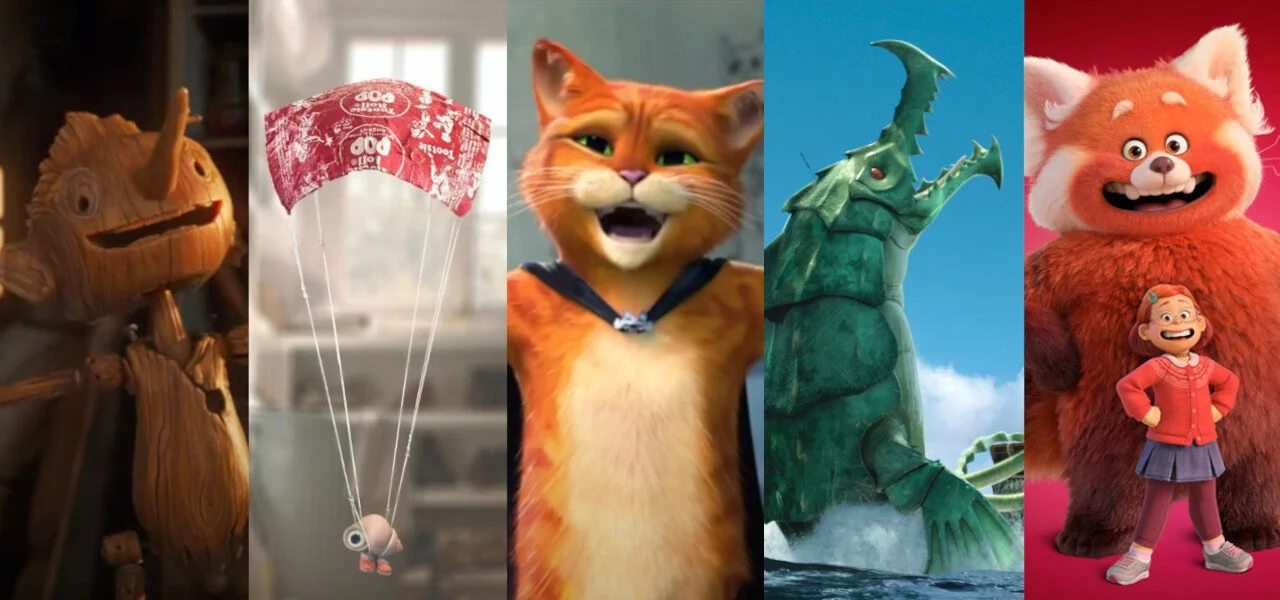Animation: A Medium, not a Genre
By Jadzia Allright
What do fascist Italy, an Airbnb, a pocket dimension, an isolated island, and 21st-century Toronto have in common? They are the settings of the five films nominated for Best Animated Feature at the 95th Academy Awards this year. In one of the strongest selections of films ever nominated, anyone could win. Guillermo del Toro's Pinocchio, Marcel the Shell with Shoes On, Puss in Boots: The Last Wish, The Sea Beast, and Turning Red all have drastically different animation styles and tones. While they can all be considered ‘family-friendly’, in past years there have been several ‘R-rated’ films in this category, ranging from inclusions of intensely violent scenes to raunchy romances. Notably, the 2016 film Sausage Party was marketed with pictures of animated hotdogs, encouraging parents to take their children to see the film, despite the 15+ rating. Children were greeted with numerous expletives, graphic deaths, and many sexual references. It became the highest-grossing R-Rated animated film ever released. Clearly, it was not intended for children, regardless of its medium.
It sometimes feels as if the Best Animated Feature category at the Oscars is colloquially referred to as the ‘Kids Movie Nomination’, where the academy decides to nominate whichever film Disney or Pixar studios releases that year. Voters have admitted that they often do not put any thought into the film they pick, either voting for the one their children enjoyed or, almost by default, for a Pixar film, due to the studio’s reputable status. Only three animated films ever have been nominated for Best Picture: Beauty and the Beast, Up, and Toy Story 3. Beauty and the Beast was nominated prior to the creation of the Best Animated Picture award, and the Academy wanted to recognise it. Up was nominated in 2010, the year in which the Best Picture nominees were expanded to include 10 films for consideration – this was a response to the public outcry that WALL-E was not nominated the year before. Disney and Pixar launched an intense marketing campaign for Toy Story 3, but it was beaten by The King’s Speech. These cases give the impression that animation is not valued by the Academy.
The very fact that there is a separate category purely for animated films makes it seem that animation is treated as a genre. Film genres are quite clear-cut: horror, action, sci-fi and thriller, just to name a few. The issue is that animated films can fit into any of these different genres easily. For example, Rango is a critically acclaimed Western where the main character just so happens to be an animated chameleon rather than a human. Although Coraline is technically a children’s film, it undoubtedly has undertones of horror and leaves many people terrified. Gnomeo and Juliet is a pretty standard retelling of Shakespeare, despite the fact that the protagonists are gnomes. These films slot perfectly into their genres, and yet would most likely be considered ‘animated’ above anything else. It is a discredit to group them together – this would be like grouping movies by the camera they are shot with rather than the content of the movies themselves.
Studio Ghibli’s work is perhaps most significant to this argument. Spirited Away tells a story which, on the surface, could be seen simply as about a girl travelling through a mystical world. However, it also delves into more serious motifs of greed, environmentalism, overconsumption, and personal identity. Kiki’s Delivery Service deals with topics such as burnout, maturity, and vulnerability. Most notably, Studio Ghibli’s Grave of the Fireflies is a Japanese war tragedy and is often considered one of the saddest films ever made. Akiyuki Nosaka, the author of the short story the film is based on, had been approached by many live-action film companies but he had declined, stating that it was impossible to get children to convincingly play the devastating story out and that the backdrop of the story could never be bleak and barren enough. Once shown the storyboards for an animated version, he concluded that it was not possible for the story to be made into a film unless it was animated.
The Best Animated Picture belittles the artform into a parade of ‘children's films’, whilst the Academy belittles it even further by refusing to recognise animated works of art in any other category. People that refuse to watch animated films are denying themselves a world in which the limitations of reality are removed. This all to say that being considered a ‘children’s film’ is not necessarily a bad thing, but it does imply that it is possible to grow out of them, when the reality is the opposite. When an adult views an animated film, they can properly appreciate the nuances, subtleties, and art form as a whole. The director of WALL-E, Andrew Stanton, once commented that, ‘it’s the complete innocence of how much it thrilled me as a kid to be moved by a movie… It only takes the right movie and I’m 10 again and want to be a part of it.’ To return to childhood is a powerful thing, and it should be respected. Animated films cannot be constrained to a single genre.
ST.ART Magazine does not own the rights to any of the images used in this article.



